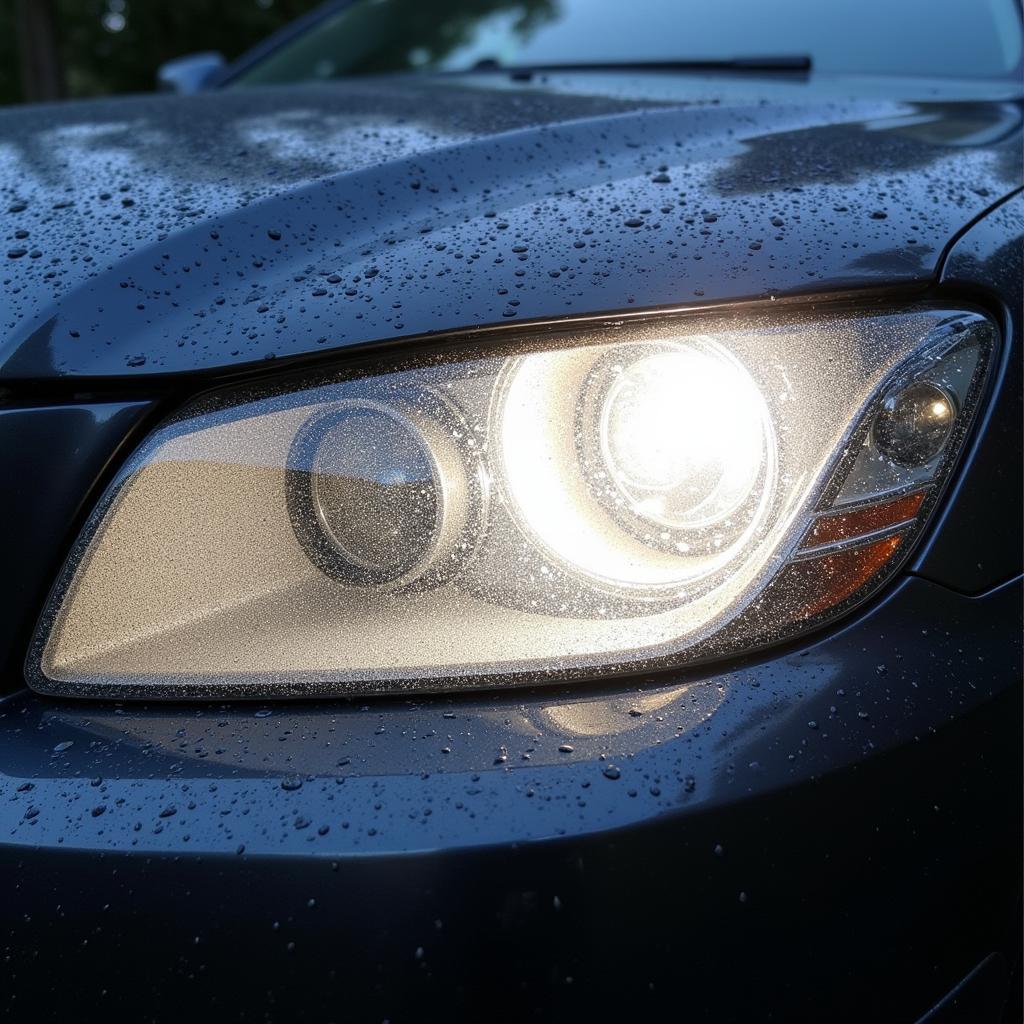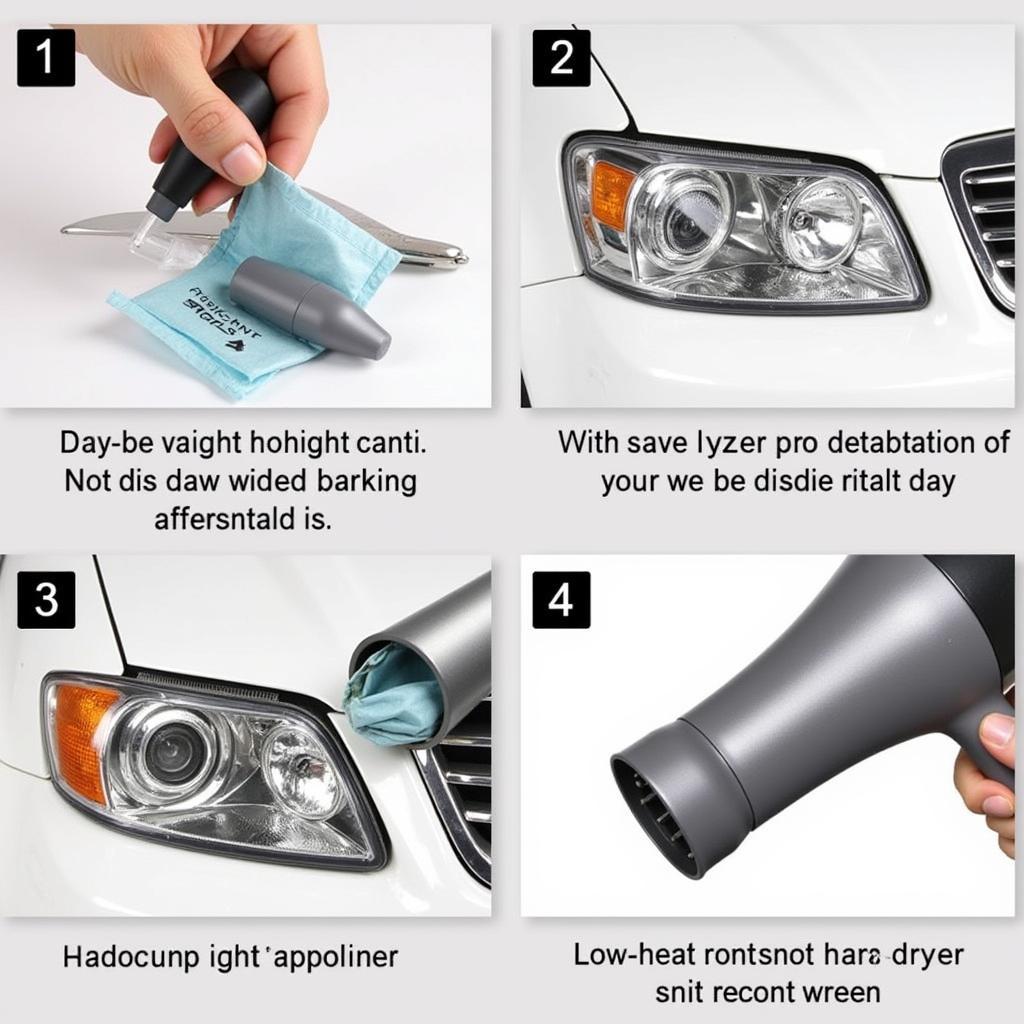Car headlight problem condensation is a common issue that can affect the performance and lifespan of your headlights. It occurs when moisture gets trapped inside the headlight assembly, leading to a foggy or hazy appearance. This article will explore the causes of headlight condensation, explain why it’s a problem, and provide practical solutions for fixing and preventing it.
Why is Headlight Condensation a Problem?
Condensation inside your headlights isn’t just an aesthetic issue. It can significantly reduce visibility, especially at night or in adverse weather conditions. The moisture can also damage internal components like the reflector and bulb, leading to premature failure. Furthermore, persistent condensation can lead to corrosion and electrical shorts, increasing the risk of fire hazards.
How Does Condensation Form in Headlights?
Headlights are designed to be relatively airtight, but they’re not completely sealed. Small vents allow for air exchange to prevent pressure buildup and temperature fluctuations. When warm, moist air enters the headlight and comes into contact with the cooler lens, it condenses into water droplets. This is more likely to occur in humid climates, after washing your car, or when driving through heavy rain or fog.
 Example of Condensation in a Car Headlight
Example of Condensation in a Car Headlight
Identifying the Source of the Problem: Cracks, Vents, and Seals
Before attempting to fix the condensation, it’s crucial to identify the source of the moisture ingress. Common culprits include cracks or damage to the headlight lens, blocked or malfunctioning vents, and deteriorated seals around the bulb or housing. Carefully inspect your headlights for any visible damage or signs of wear and tear.
Fixing Headlight Condensation: DIY and Professional Solutions
Several methods can be used to remove condensation from headlights, ranging from simple DIY fixes to professional repairs. For minor condensation, parking your car in a sunny spot with the headlights on low beam can sometimes evaporate the moisture. Another DIY option is to use desiccant packs placed inside the headlight assembly to absorb the moisture. For more persistent or severe cases, removing the headlight assembly and thoroughly drying it, or replacing the damaged seals or vents, may be necessary. If you’re uncomfortable working on your car’s electrical system, it’s always best to consult a qualified mechanic.
 DIY Fix for Headlight Condensation
DIY Fix for Headlight Condensation
Preventing Headlight Condensation: Tips and Tricks
Preventing headlight condensation is often easier than fixing it. Regularly inspecting your headlights for damage and ensuring proper ventilation can help minimize the risk of moisture buildup. Applying a sealant to the headlight seams can also improve the airtightness of the assembly.
What if the Condensation Returns?
If the condensation returns after you’ve attempted to fix it, the problem may be more complex than initially thought. A recurring condensation issue could indicate a hidden crack, a faulty vent, or a problem with the headlight’s internal design. In such cases, it’s recommended to seek professional help from a qualified auto technician.
 Professional Headlight Repair
Professional Headlight Repair
Car Headlight Condensation: The Long-Term Impact
Ignoring car headlight problem condensation can lead to costly repairs down the road. By addressing the issue promptly and taking preventative measures, you can extend the lifespan of your headlights, improve visibility, and ensure your safety on the road.
“Addressing headlight condensation promptly is crucial for both safety and preserving the integrity of the headlight assembly,” advises Robert Johnson, a certified automotive electrician with over 20 years of experience. He adds, “Early intervention can prevent more serious issues like electrical shorts and corrosion.”
Conclusion: Keeping Your Headlights Clear and Bright
Car headlight problem condensation is a common yet often overlooked issue. Understanding the causes, consequences, and solutions can help you keep your headlights clear, bright, and functioning optimally. Don’t let a foggy headlight dim your driving experience—take action today to resolve and prevent condensation. For expert advice and assistance, contact AutoTipPro at +1 (641) 206-8880 or visit our office at 500 N St Mary’s St, San Antonio, TX 78205, United States.
 Clear Headlights for Safe Night Driving
Clear Headlights for Safe Night Driving
FAQ
- How long does it take for condensation to dry out of a headlight? This can vary depending on the severity of the condensation and the method used to remove it, but it can range from a few hours to a few days.
- Can I use a hair dryer to remove headlight condensation? While a low-heat hair dryer can sometimes be effective, it’s important to be cautious and avoid overheating the lens or internal components.
- Is headlight condensation covered under warranty? It depends on the specific warranty and the cause of the condensation. If it’s due to a manufacturing defect, it might be covered.
- How often should I check my headlights for condensation? It’s a good idea to check your headlights regularly, especially during periods of high humidity or after washing your car.
- What are the signs of a failing headlight seal? Signs include persistent condensation, water leaks, and visible cracks or damage to the seal itself.
- Can I replace a headlight seal myself? Replacing a headlight seal is a relatively simple DIY task, but it requires some basic tools and knowledge of your car’s headlight assembly.
- What is the cost of professional headlight repair? The cost can vary depending on the extent of the damage and the specific make and model of your car, but it can range from $50 to $200 or more.





Leave a Reply